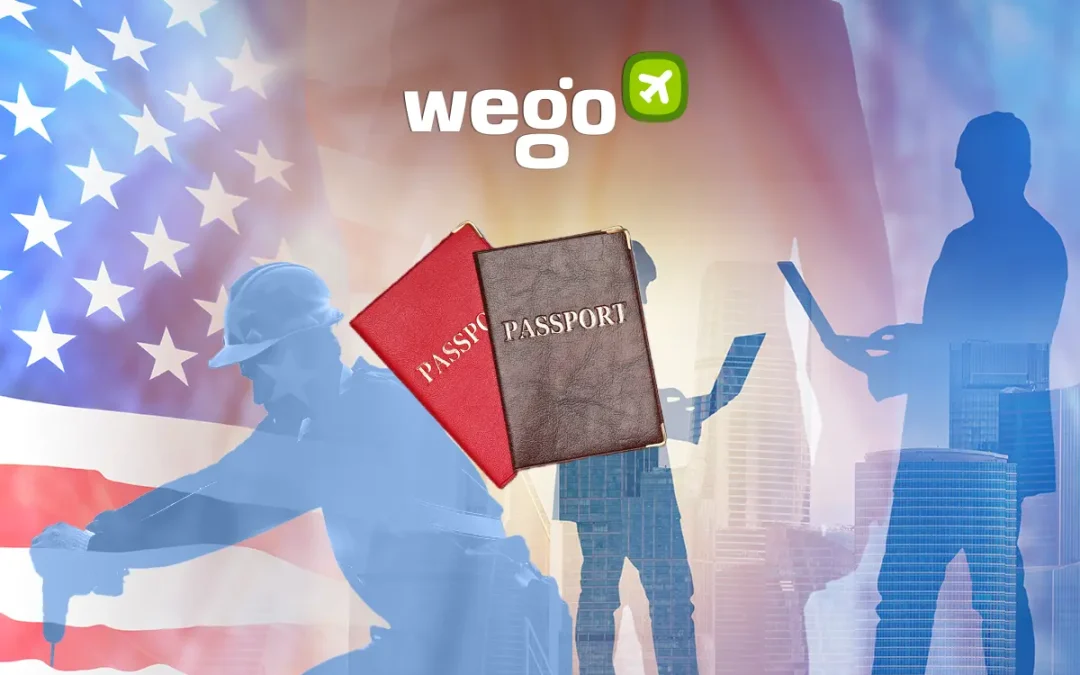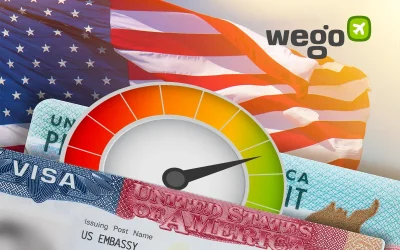This article is reviewed regularly by Wego’s editorial team to ensure that the content is up to date & accurate.
Updated September 2023
The United States of America has consistently emerged as a preferred destination for migrant workers seeking promising opportunities. The EB-1 visa, colloquially known as the Einstein visa, is a testament to the USA’s keen focus on recognizing and rewarding exceptional talent. Designed to attract individuals with extraordinary abilities, outstanding academic prowess, or remarkable managerial skills, the EB-1 visa reflects the nation’s dedication to nurturing and harnessing exceptional potential.
In this article, Wego will provide you with the necessary information on the USA’s EB-1, or Einstein visa.
Table of Contents
EB-1 visa
The EB-1 visa is a type of employment-based immigrant visa category in the United States. It is intended for individuals with extraordinary abilities in certain fields, outstanding researchers or professors, and multinational managers or executives. The EB-1 visa is part of the broader employment-based immigration system and falls under the first preference category.
The EB-1 visa is held in high regard, owing to its exclusivity, which gives it the epithet of the Einstein visa, a homage to the exceptional scientist Albert Einstein.
Holders of the EB-1 visa are exempt from requiring a labor certification from the US Department of Labor. Additionally, the EB-1 visa is known for the priority given to it in the green card (permanent residency) application process. Thus, individuals who qualify for the EB-1 visa may be able to obtain a green card more quickly than through some other employment-based categories.
EB-1 visa categories
There are three categories within the EB-1 visa. The categories are as follows.
Extraordinary Ability
This category is for individuals who have demonstrated extraordinary abilities in the sciences, arts, education, business, or athletics. Applicants must provide extensive evidence of their achievements and recognition in their respective fields. They do not require a specific job offer or labor certification.
Outstanding Professors and Researchers
This category is for individuals who are internationally recognized as outstanding in their academic field. Applicants must have a job offer for a tenure-track position or a comparable research position at a US university or research institution. They also need to demonstrate a certain level of accomplishment and recognition in their field.
Certain Multinational Managers or Executives
This category is for exceptional multinational executives or managers who have worked for a multinational company outside the US for at least 1 year in the 3 years preceding the application or since their most recent legal entry into the US if they are already working for the US-based sponsoring employer. This visa is sponsored by a US-based employer who intends to hire the applicant for a higher management role.
EB-1 visa eligibility criteria
Each of the categories mentioned above has its own set of eligibility criteria and requirements. Here are the requirements for each of these categories:
Extraordinary Ability
The following criteria serve to demonstrate that the applicant’s achievements have been recognized in their field of expertise. Applicants applying under this category must provide any 3 of the 10 listed criteria.
- evidence of receipt of lesser nationally or internationally recognized prizes or awards for excellence
- evidence of your membership in associations in the field that demand outstanding achievement of their members
- evidence of published material about you in professional or major trade publications or other major media
- evidence that you have been asked to judge the work of others, either individually or on a panel
- evidence of your original scientific, scholarly, artistic, athletic, or business-related contributions of major significance to the field
- evidence of your authorship of scholarly articles in professional or major trade publications or other major media
- evidence that your work has been displayed at artistic exhibitions or showcases
- evidence of your performance in a leading or critical role in distinguished organizations
- evidence that you command a high salary or other significantly high remuneration in relation to others in the field
- evidence of your commercial successes in the performing arts
Please note that comparable evidence is also acceptable if any of the criteria do not readily apply.
Alternatively, applicants can provide evidence of a one-time achievement (i.e., Pulitzer, Oscar, Olympic medal, or any comparable award in their field) as well as evidence showing that they will be continuing to work in their area of expertise.
Outstanding Professors and Researchers
The following criteria serve to demonstrate an applicant’s acumen as an outstanding professor or researcher. Applicants applying under this category must provide any 2 of the 6 listed criteria.
- evidence of receipt of major prizes or awards for outstanding achievement
- evidence of membership in associations that require their members to demonstrate outstanding achievement
- evidence of published material in professional publications written by others about the noncitizen’s work in the academic field
- evidence of participation, either on a panel or individually, as a judge of the work of others in the same or allied academic field
- evidence of original scientific or scholarly research contributions in the field
- evidence of authorship of scholarly books or articles (in scholarly journals with international circulation) in the field
Additionally, the applicant must provide an offer of employment from the prospective US employer. The private employer must show documented accomplishments and that it employs at least 3 full-time researchers.
Certain Multinational Managers or Executives
Here is the eligibility criteria for applying under this category:
- the petitioning employer needs to be a US employer, with the intention of employing the applicant in a managerial or executive role
- the petitioner must demonstrate at least 1 year of active business operation within the US
- there should exist a qualifying relationship between the US petitioner and the entity abroad that previously employed the applicant in a managerial or executive capacity
EB-1 visa application process
The application process for various EB-1 visa categories varies according to category. Here’s how it works for each category:
Extraordinary Ability
- Applicants seeking the EB-1A visa category can apply on their own behalf, by submitting Form I-140, Petition for Alien Worker.
Outstanding Professors and Researchers
- for those applying under the EB-1B visa category, the U.S. employer must file Form I-140
- additionally, the employer must show a continuing ability to pay the offered wage as of the priority date. Evidence of this can be provided through an annual report, federal income tax return, or audited financial statement
Multinational Manager or Executive
- applicants in the EB-1C visa category require their U.S. employer to file USCIS Form I-140
- similarly, the employer must show a continuing ability to pay the offered wage as of the priority date. Evidence of this can be provided through an annual report, federal income tax return, or audited financial statement
Please note that United States Citizenship and Immigration Services (USCIS) may require that the applicant appear for an interview or provide biometrics (for example, fingerprints, photograph, and/or signature) at any time to verify their identity, obtain additional information, and conduct background and security checks, including a check of criminal history records maintained by the Federal Bureau of Investigation (FBI), before making a decision on the application. After USCIS receives the application and ensures it is complete, the applicant will be informed in writing if they need to attend a biometric services appointment.
EB-1 visa processing time
The time taken for the processing of an EB-1 visa depends on several factors, such as the category of visa you are applying for, the US state you are applying in, the time taken to verify your documents or the requirement of interview or biometrics. According to Wego’s research, the processing times can range from 8-9 months to as long as 21-23 months in some cases.
The stages of the processing of your application are as follows:
- initial processing: USCIS checks petitions for completeness; incomplete forms can lead to rejection or denial
- requests for more information: USCIS may ask for additional evidence or originals of submitted copies if needed
- requests for interview: USCIS may require an interview at a USCIS office, including providing biometrics for identity verification and security checks
- decision: USCIS determines if eligibility for the immigration benefit is met; the decision is communicated in writing
- petition approval: Approval confirms the eligibility of the applicant for the requested classification
EB-1 visa validity
The EB1 visa offers a clear pathway to attaining permanent residency in the United States through the Green Card application process. Once granted, the Green Card issued to EB-1 visa holders remains valid for a decade, a notably longer duration compared to most other immigrant visas in the country. To uphold your permanent resident status, it is essential to complete the Green Card renewal process, typically involving the submission of Form I-90.
If there have been no significant changes in your permanent resident status, such as criminal convictions or a disruption in your commitment to residing in the US, the renewal process should proceed smoothly. You retain the flexibility to renew your Green Card as often as needed, ensuring your continuous standing as a permanent resident.
Alternatively, eligible individuals have the option to pursue citizenship through naturalization once they meet the criteria. This route eliminates the necessity for Green Card renewal altogether, providing a direct path to becoming a US citizen.
EB-1 visa fees
The fee for applying for an EB-1 visa by filing an I-140 form is USD 700. This is a flat, non-refundable fee and can be paid via a money order, personal check, cashier’s check, or by credit card using Form G-1450, Authorization for Credit Card Transactions. If you pay by check, you must make your check payable to the US Department of Homeland Security.
EB-1 visa dependents policy
If an applicant’s I-140 petition is approved, their spouse and unmarried children under the age of 21 may be eligible to apply for admission to the United States in E-14 or E-15 immigrant status, respectively.
EB-1 visa bulletin
USCIS, in coordination with the Department of State, is revising the procedures for determining visa availability for applicants waiting to file for employment-based or family-sponsored preference adjustment of status. The revised process will better align with procedures the State uses for foreign nationals who seek to become US permanent residents by applying for immigrant visas at US consulates and embassies abroad. The current visa bulletin was issued in August 2023, and a new one is scheduled to be released in September 2023.
You can view the visa bulletin from the US Department of State’s official website.
EB-1 visa to Green Card
US immigration law provides immigrants with a variety of ways to become lawful permanent residents, otherwise known as getting a Green card, through employment in the United States. The EB-1 visa category is the first preference when it comes to Green Card application, which contributes to its coveted status.
You can apply for a Green Card as soon as you receive your EB-1 visa, provided that a visa is available in your category. In order to apply for permanent residency, you need to be physically present in the United States and submit Form I-485 to USCIS. This process takes about six months, and upon approval, you’ll receive a green card as evidence of your permanent resident status.













